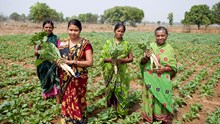
High in the Himalayan ranges, where life is shaped by snow-clad peaks and difficult terrain, local communities have created food traditions that are deeply tied to survival and sustainability. One such treasure is Chhurpi, a unique cheese that has been prepared for centuries in Nepal, Bhutan, Sikkim, and Darjeeling. Unlike ordinary cheese that spoils quickly, Chhurpi can last for months, even years, without refrigeration. It is not just food but a cultural bond, a way of preserving milk in places where cold storage is absent and markets are far away. For mountain farmers and herders, Chhurpi is more than a snack; it represents resilience, resourcefulness, and the strength of rural communities.
How Chhurpi is Made
The process of making Chhurpi is as natural and simple as the mountain lifestyle itself. Fresh milk from cows or yaks is collected and boiled, after which it is curdled using sour milk or lime juice. The curds are separated from the whey and pressed to remove water. At this stage, the soft form of Chhurpi is ready, which is chewy and can be eaten fresh. For the hard variety, the cheese is further dried and smoked for weeks, making it extremely hard and long-lasting. Farmers often hang the cheese in kitchens above wood fires, where the smoke slowly hardens it into a tough block that can be chewed for hours.
Soft and Hard Varieties
Chhurpi exists in two distinct forms, each serving a different purpose in daily life. The soft version is usually eaten as a fresh snack or cooked with vegetables, soups, and pickles. It has a mild, tangy taste and is rich in protein. The hard version, on the other hand, is so tough that it can take hours to soften in the mouth. This version has gained global popularity as a natural dog chew, marketed as a healthy and long-lasting alternative to processed pet treats. What started as a mountain survival food has now found a place in international markets, connecting remote farmers with new opportunities.
Farming, Milk, and Livelihoods
At the heart of Chhurpi is the bond between farmers and their cattle. In the Himalayan region, raising cows and yaks is not easy due to limited grazing lands, harsh climates, and long winters. Yet, families continue the tradition because milk is their lifeline. By turning milk into Chhurpi, they are able to store food for difficult months and also earn money in local markets. For many small dairy farmers, Chhurpi production provides steady income and reduces dependency on outside food sources.
Nutritional and Health Value
Chhurpi is not just about taste; it is packed with nutrition. Being rich in protein, calcium, and essential micronutrients, it supports bone strength, muscle health, and overall energy. For people in the mountains who do hard physical work and face extreme weather, such nutrient-dense food is essential. Unlike heavily processed cheese varieties, Chhurpi contains no artificial preservatives, making it a pure and natural food choice. Its low fat content also makes it suitable for those seeking healthy dairy options.
Cultural and Social Importance
Chhurpi holds a deep place in Himalayan culture. It is part of daily meals, festive occasions, and local traditions. In some villages, offering Chhurpi to guests is a sign of respect and hospitality. Children grow up chewing small pieces of it, while elders carry it as a pocket snack during long walks in the hills. Its presence in both food and culture reflects how communities adapt their resources to meet not only physical needs but also social and emotional ones.
Chhurpi in Global Markets
In recent years, Chhurpi has crossed the borders of Himalayan homes to reach international shelves. The hard variety, particularly, has become popular in Europe and America as a natural chew for dogs. This shift has opened new opportunities for mountain farmers and cooperatives to increase their income. However, challenges remain in terms of standardization, hygiene, and sustainable production. Supporting farmers with better training, market access, and fair pricing can ensure that this traditional food continues to thrive in modern times.
Chhurpi is more than just cheese; it is a story of survival, tradition, and farmer wisdom. It shows how rural communities transform limited resources into something valuable, nourishing, and long-lasting. As global interest grows, there is an opportunity to promote Chhurpi not just as a product but as a heritage food linked to the hard work of Himalayan farmers. By supporting its production, we are not only preserving a centuries-old tradition but also strengthening the livelihoods of those who live closest to nature.
















